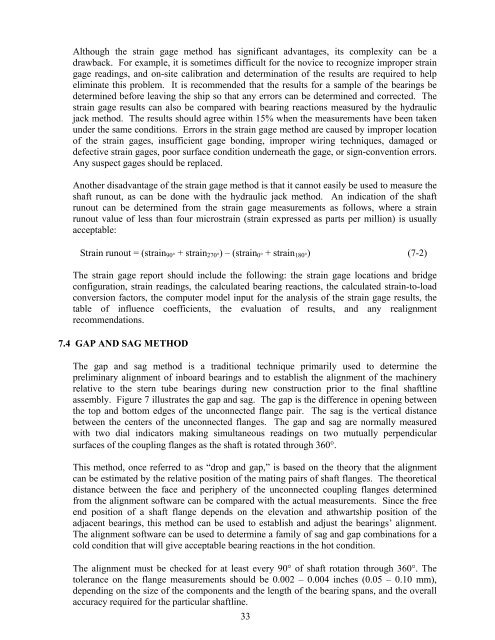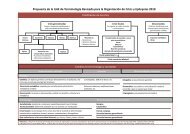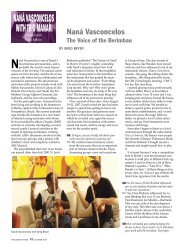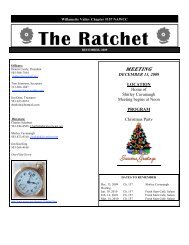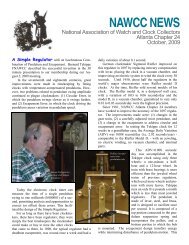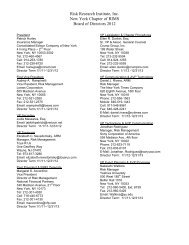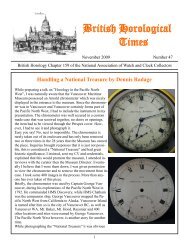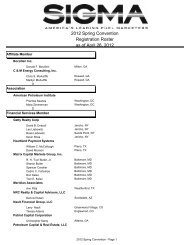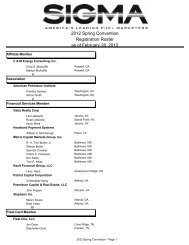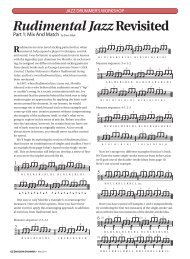Technical and Research Bulletin 3-51 - Amazon Web Services
Technical and Research Bulletin 3-51 - Amazon Web Services
Technical and Research Bulletin 3-51 - Amazon Web Services
You also want an ePaper? Increase the reach of your titles
YUMPU automatically turns print PDFs into web optimized ePapers that Google loves.
Although the strain gage method has significant advantages, its complexity can be a<br />
drawback. For example, it is sometimes difficult for the novice to recognize improper strain<br />
gage readings, <strong>and</strong> on-site calibration <strong>and</strong> determination of the results are required to help<br />
eliminate this problem. It is recommended that the results for a sample of the bearings be<br />
determined before leaving the ship so that any errors can be determined <strong>and</strong> corrected. The<br />
strain gage results can also be compared with bearing reactions measured by the hydraulic<br />
jack method. The results should agree within 15% when the measurements have been taken<br />
under the same conditions. Errors in the strain gage method are caused by improper location<br />
of the strain gages, insufficient gage bonding, improper wiring techniques, damaged or<br />
defective strain gages, poor surface condition underneath the gage, or sign-convention errors.<br />
Any suspect gages should be replaced.<br />
Another disadvantage of the strain gage method is that it cannot easily be used to measure the<br />
shaft runout, as can be done with the hydraulic jack method. An indication of the shaft<br />
runout can be determined from the strain gage measurements as follows, where a strain<br />
runout value of less than four microstrain (strain expressed as parts per million) is usually<br />
acceptable:<br />
Strain runout = (strain90° + strain270°) – (strain0° + strain180°) (7-2)<br />
The strain gage report should include the following: the strain gage locations <strong>and</strong> bridge<br />
configuration, strain readings, the calculated bearing reactions, the calculated strain-to-load<br />
conversion factors, the computer model input for the analysis of the strain gage results, the<br />
table of influence coefficients, the evaluation of results, <strong>and</strong> any realignment<br />
recommendations.<br />
7.4 GAP AND SAG METHOD<br />
The gap <strong>and</strong> sag method is a traditional technique primarily used to determine the<br />
preliminary alignment of inboard bearings <strong>and</strong> to establish the alignment of the machinery<br />
relative to the stern tube bearings during new construction prior to the final shaftline<br />
assembly. Figure 7 illustrates the gap <strong>and</strong> sag. The gap is the difference in opening between<br />
the top <strong>and</strong> bottom edges of the unconnected flange pair. The sag is the vertical distance<br />
between the centers of the unconnected flanges. The gap <strong>and</strong> sag are normally measured<br />
with two dial indicators making simultaneous readings on two mutually perpendicular<br />
surfaces of the coupling flanges as the shaft is rotated through 360°.<br />
This method, once referred to as “drop <strong>and</strong> gap,” is based on the theory that the alignment<br />
can be estimated by the relative position of the mating pairs of shaft flanges. The theoretical<br />
distance between the face <strong>and</strong> periphery of the unconnected coupling flanges determined<br />
from the alignment software can be compared with the actual measurements. Since the free<br />
end position of a shaft flange depends on the elevation <strong>and</strong> athwartship position of the<br />
adjacent bearings, this method can be used to establish <strong>and</strong> adjust the bearings’ alignment.<br />
The alignment software can be used to determine a family of sag <strong>and</strong> gap combinations for a<br />
cold condition that will give acceptable bearing reactions in the hot condition.<br />
The alignment must be checked for at least every 90° of shaft rotation through 360°. The<br />
tolerance on the flange measurements should be 0.002 – 0.004 inches (0.05 – 0.10 mm),<br />
depending on the size of the components <strong>and</strong> the length of the bearing spans, <strong>and</strong> the overall<br />
accuracy required for the particular shaftline.<br />
33


